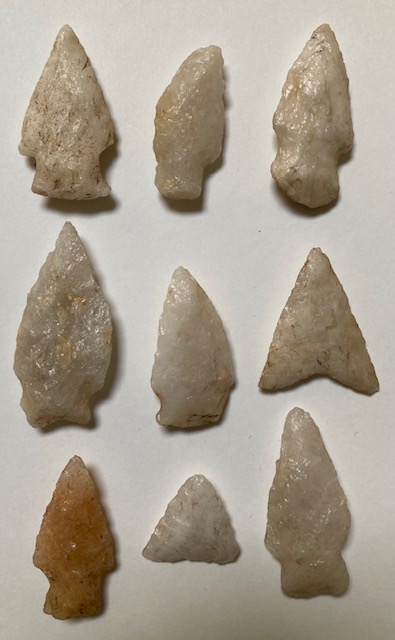
As a youngster, a neighbor on Oak Island was digging for clams with his feet (“Treading”), when he stumped his foot on what he thought was the largest chowder he ever had the pleasure to find. He bent down and dug around until he came up with a large black stone. Washing it off he could see it was an ancient stone axe head. How old was it? Hard to say. But by the shape, size and type of stone, it matches other museum pieces from the Archaic period going back to as much as 10,000 B.C. It might even be as old as from the Paleolithic period 15,000 years ago. Suffice to say it was way, way, before the invention of the outboard motor. It’s easier for us mariners to wrap our heads around that time comparison, especially when you realize that was the era of mastodons, sabre tooth tigers, and giant sloths on land, and who knows what in the ocean.

As we fly across our bays or plow through the inlets to the Bacardi, Chicken Canyon, Hudson Canyon or Mudhole we tend to enjoy that day and rarely think of Paleontology. At least, I don’t. I have never had an intense conversation on the subject while gaffing mahi-mahi. Yet the evidence of ancient humans is often right below our hulls or close to where we dock our boats on any river or bay marina be it in Amityville, Merrick, Essex Connecticut, Raritan Bay or any water access area all along the east coast, evidence from pre-historic humankind may sit preserved in the silt and sand. Even well beyond the confines of our bays, creeks, rivers and coves lies a treasure trove of early mankind’s history and artifacts in our ocean”. Recently off Chesapeake, a fishing trawler hauled up mastodon bones with a spear flint point embedded in them. Commercial fishermen have been ripping their nets on and pulling up their tusks for years. It doesn’t happen every day, but it does happen, while all along our local shores beachcombers find arrow and spear tips, mastodon bones, and their giant mashing teeth. Many people pick them up and put them back down being unaware of what they have come across. All these artifacts have remained pristine because they become protected in time by a covering of sand or mud. The perfect preservative.

How did this transpire? In order to figure that out, scientists have had to backtrack to the era before and after the great glaciers extended to our area thousands of years ago. Humans were able to cross into North America across ice bridges from the Bering Straits in the west and across from Europe in the east. They settled below the edge of the glacier on the plains and woodlands that extended approximately 125 miles out to where the Hudson Canyon and its continuum extends north and south.. This period is called the Paleolithic period.
If a Paleolithic Robert Moses had built Jones Beach, it would lie 125 miles south of where we swim, surf, boat, and sun today.
The glacier formed the mountains (Catskills, Gunks, Ramapo, Berkshires, and Poconos) to the north of us where the Appalachian Trail runs. Long Island was formed by debris pushed up in front of the glacier ice. Lands below the glacier had gentle hills and plains rolling out to the edge of the canyon where the ocean waves lapped. The area was covered with both conifer forests and grass savannahs where herds of prehistoric bison, mastodon, elk, and deer – you name it – roamed and were one the major food sources of these early inhabitants. It was a perfect place to settle down kinda like the first “Levittown” for Native Americans..
Then a little thing called “Global Warming B.C.” started. As the atmosphere heated, melting glacier ice became creeks, rivers, bays, and the Long Island Sound (Previously a lake). As this water spilled down the ocean rose higher and higher from the ice melt. Paleolithic humans slowly migrated backward as more land was consumed by the rising oceans. They left behind tools, weapons, and butchered animals. Eventually, they hunted mastodons and other species out of existence. Larger animals usually have fewer populations and suffer from over hunting sooner than the smaller, faster producing animals like deer, elk, fowl and fish.
Once the glacier melted entirely the coastline stabilized to basically where we know it to be today (At least for another five years!). Life settled into what is titled the early Archaic period. The weather was much warmer, and the conifer forests were replaced with larger oaks, elms, and maples, on the hilly North Shore. Closer to the ocean were some grasslands, smaller pitch pines and pin oak woodlands flowing down to wetlands along the coast of Jersey, Delaware, Maryland, Long Island, etc. During this period, fish and shellfish became the staple food source and the infancy of agriculture of maize and squash began.
The inhabitants lived in small villages along the creeks, rivers, and bays during warmer weather and moved into the woodlands for winter. Their tools such as spear and arrow tips and the flakes (Chips) that were cast-off to form them remained scattered about any area that they lived in. Most of the arrowheads you may find along coastal areas are quartz, which is easy to chip into fine hunting and offensive/defensive arrow points, spear points, scrapers, and knife blades. Darker stone points were traded by visitors from other areas in the interior such as upper New York State up into the mountains of the Appalachians which were the major source of these points. You can also find black, intensely sharp, glass like, black obsidian from Ohio and beyond which were also reaching the coastal archaic inhabitants by burgeoning, intertribal trade.
Ax heads for both tool and war use were chipped and formed earlier from large quartz pieces and later more sophisticated pieces from harder granite stone from the rocky areas to the north which were the residue of where the glacier had stopped. Stone bowls, mortises, round grinding stones, hoe heads, and adz heads were formed from both quartz and granite. Fishing sinkers, net sinkers and fish scalers were also made by flaking various stones. All these implements can still be found along our beaches and along and in our creeks and rivers and coastal woodlands and fields to this day.
From the late archaic period through the late woodland period, from approximately 4000 B.C. to European contact, these inhabitants also began making fine pottery bowls and other food containers from the clay found in the wetlands and began to beautifully decorate them, pieces of them are still found along our shores. Trade between tribes was facilitated by their ability to fashion large canoes from logs. They burned out the centers and used their stone adzes to form small canoes for a couple of people to large ones that could carry 25 passengers or more. They became a sea culture in many ways and later even showed the colonists how to hunt whales that came down the shore each year.
They also developed wampum, which is the bluest part of the quahog clams made into beads and strung together, which was used as money and traded up and down the coast. Once the Europeans’ arrived wampum was used to trade for combs, knives, spoons, mirrors, gunpowder, iron axes, adzes, hoes, knives and metal to make arrowheads, etc. These iron implements can be found but rarely are they in as pristine condition as the older stone artifacts as they are subject to rust. The age of utilitarian stone passed. Its remnants can be found below our boats. I have quite a few samples of these ancient implements collected by one of the colonial families in the rivers on their land grant in the 1700s. I have the provenance on them and have several museums hoping I will donate them at some point, which I will.
Today, there is a new breed of archaeologists exploring our local waters and way out into the ocean to re-interpret our first coastal inhabitants. They dive down and use small submersible cameras and imaging equipment to find new clues. In the future, our knowledge of these people may completely change from what we assumed. As we engage in humankind’s earliest relationship with the ocean, bays, rivers and streams keep in mind that they loved the same things we do. They walked the beaches, fished, and ate feasts of clams, oysters, crabs, and lobsters, leaving huge shell middens (Piles of discarded shells). They were human!
So, when you skit down the Amityville Cut, the Manasquan, Connecticut, Hudson River, the Sound, or sail out into the ocean, remember, there were people here before us and the proof often lies along our shores and beneath our hulls.
C. 2022 by Mark C. Nuccio, All rights reserved
For all copy, photographs and illustrations
